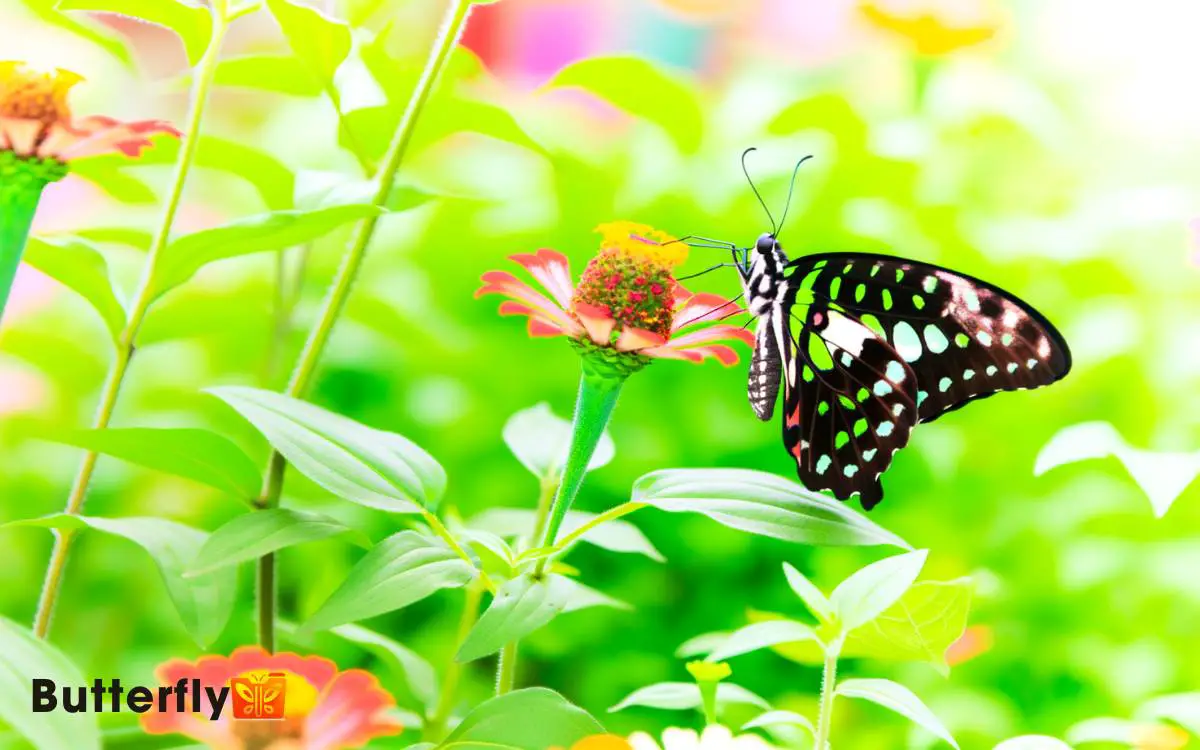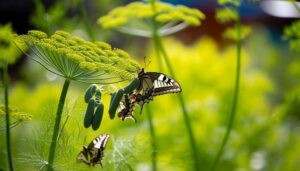Butterfly With Black Winged Green and White Swallowtail Papilionidae!
The Black Winged Green and White Swallowtail, a notable member of the Papilionidae family, dazzles with iridescent green patterns and bold black wing edges.
Its elongated forewings and swallow-like tails aid agile flight, essential in Southeast Asia’s tropical forests. This butterfly thrives in warm, humid environments, feeding on nectar from milkweed and lantana.
Its life cycle includes egg, larva, pupa, and adult stages, with adults noted for their aerial displays and territorial behavior.
Conservation efforts focus on protecting habitats and monitoring populations. For those intrigued by its ecological significance, there’s much more to uncover.

Key Takeaways
Physical Characteristics
The butterfly known as the black-winged green and white swallowtail from the Papilionidae family exhibits strikingly distinct physical characteristics, including iridescent green patterns and bold black wing edges. This remarkable butterfly is often mistaken for the black and blue swallowtail, but its vibrant green hues set it apart. It thrives in tropical forests, where its bold coloration provides camouflage among dense foliage. The black-winged green and white swallowtail is also known for its swift, graceful flight, making it a captivating sight for butterfly enthusiasts.
These butterflies display an exquisite contrast between their vivid green and white spots, which shimmer under sunlight.
Their forewings are elongated, contributing to their graceful flight. The hindwings feature pronounced tails, resembling the shape of a swallow’s tail, hence their name. Additionally, the underside of the wings is designed with intricate markings that aid in camouflage when resting.
Each wing spans approximately 8-10 centimeters, making them a mesmerizing sight in their natural environment. Their antennae are club-shaped, aiding in navigation and sensory perception, while their bodies are slender and streamlined.
Habitat and Distribution
The Black Winged Green and White Swallowtail Papilionidae thrives in tropical and subtropical climate zones, favoring warm and humid environments. Its geographic range spans across Southeast Asia, extending to parts of India and southern China.
These butterflies are commonly found in rainforests, deciduous forests, and occasionally in cultivated areas.
Preferred Climate Zones
Mostly inhabiting tropical and subtropical regions, the Black Winged Green and White Swallowtail Papilionidae thrives in climates that offer high humidity and abundant vegetation.
These butterflies prefer dense forests, where they find ample nectar sources and host plants for their larvae.
They are particularly adapted to environments with consistent moisture levels, which support their delicate wings and overall physiology. Seasonal variations in temperature are minimal, ensuring a stable habitat year-round.
Below is a table summarizing their preferred climate conditions:
| Climate Aspect | Preferred Condition |
|---|---|
| Humidity | High (70-90%) |
| Vegetation | Abundant, diverse flora |
| Temperature | Warm (20-30°C) |
| Rainfall | Moderate to heavy (1000-3000 mm/year) |
These conditions collectively offer the ideal setting for their survival and proliferation.
Geographic Range
Black Winged Green and White Swallowtail Papilionidae inhabit a broad geographic range, primarily spanning tropical and subtropical regions across multiple continents.
Their distribution includes parts of Southeast Asia, Central and South America, and certain regions of Africa. These butterflies thrive in diverse habitats, from lowland rainforests to mountainous terrains, adapting to elevations ranging from sea level to several thousand meters.
They favor environments rich in host plants important for larval development, particularly those in the Rutaceae family. The species exhibits remarkable adaptability, enabling it to colonize various ecosystems.
Seasonal migrations are common, triggered by climatic changes, ensuring access to ideal conditions for feeding and breeding.
Their widespread presence underscores their ecological resilience and adaptability.
Feeding Habits
The Black Winged Green and White Swallowtail Papilionidae primarily consumes nectar from a variety of flowering plants, particularly favoring those with tubular-shaped blooms.
They exhibit peak feeding activity during early morning and late afternoon, which coincides with ideal nectar availability.
Detailed analysis of their dietary preferences reveals a strong inclination towards specific plant species that offer high energy yield.
Preferred Nectar Sources
Frequently observed in meadows and gardens, the black-winged green and white swallowtail Papilionidae primarily feeds on nectar from a variety of flowering plants, showing a marked preference for milkweed, lantana, and thistle.
These butterflies are drawn to the vibrant colors and abundant nectar of these flowers, which provide essential nutrients for their survival and reproduction.
The following table lists the preferred nectar sources, highlighting the plant species and their attributes:
| Plant Species | Flower Color | Nectar Abundance |
|---|---|---|
| Milkweed | Pink/Orange | High |
| Lantana | Multi-color | Moderate |
| Thistle | Purple | High |
Feeding Time Patterns
Observations indicate that the black-winged green and white swallowtail Papilionidae exhibits peak feeding activity during the early morning and late afternoon hours.
Researchers note that these timeframes coincide with ideal light and temperature conditions, facilitating efficient nectar foraging.
During these periods, the butterfly demonstrates heightened sensory acuity and increased flight activity, enabling it to locate and exploit floral resources effectively.
The morning and afternoon feeding windows also minimize competition with other nectar-feeding insects.
This temporal feeding pattern guarantees that the swallowtail maximizes its energy intake while avoiding the midday heat, which can be detrimental to its delicate physiology.
By adhering to these specific feeding times, the black-winged green and white swallowtail optimizes its survival and reproductive success.
Dietary Preferences Analysis
An analysis of the black-winged green and white swallowtail Papilionidae’s dietary preferences reveals a strong affinity for high-sucrose nectar sources, mainly from brightly colored, tubular flowers.
This butterfly species primarily targets flowers from the genera Lantana, Honeysuckle, and Buddleia, which provide the essential carbohydrates needed for their energy-intensive flight.
It’s noteworthy that they exhibit a preference for red and orange hues, which are more visible to their vision spectrum.
Additionally, they consume mineral-rich moisture from damp soil, a behavior known as mud-puddling. This practice supplements their diet with essential salts and amino acids.
These dietary habits underscore the butterfly’s adaptive strategies for nutrition, ensuring survival and effective reproduction in their natural habitats.
Life Cycle Stages
The life cycle of the Black Winged Green and White Swallowtail Papilionidae unfolds through four distinct stages: egg, larva, pupa, and adult butterfly.
Each stage is vital for its development and survival.
- Egg: The female lays tiny, round eggs on host plants. These eggs hatch within a few days.
- Larva: The emerging caterpillar feeds voraciously on the host plant, undergoing several molts as it grows.
- Pupa: After reaching full larval size, it forms a chrysalis, within which metamorphosis occurs.
- Adult Butterfly: The mature butterfly emerges, ready to feed, mate, and continue the cycle.
This precise sequence ensures the survival and propagation of this visually stunning species, adapted to their ecological niche.
Behavior and Flight
After emerging from the chrysalis, the Black Winged Green and White Swallowtail Papilionidae displays intricate flight patterns and behaviors important for its survival and reproduction.
Its agile flight allows it to evade predators and locate mates efficiently. The butterfly employs a combination of rapid wing beats and gliding to navigate its environment.
During courtship, males perform elaborate aerial displays to attract females, showcasing their vibrant wing colors. This species also exhibits territorial behavior, with males fiercely defending their chosen areas.
They frequently visit flowers, utilizing their proboscis to feed on nectar, which fuels their high-energy activities.
These behaviors and flight dynamics play a significant role in their ecological interactions and overall lifecycle.
Conservation and Threats
Conservation efforts for the Black Winged Green and White Swallowtail Papilionidae focus on habitat preservation due to increasing threats from deforestation and climate change. These butterflies require specific host plants and forest environments to thrive.
Key actions include:
- Protecting critical habitats: Establishing reserves and protected areas to conserve essential ecosystems.
- Promoting sustainable forestry: Implementing practices that minimize habitat destruction.
- Restoring degraded lands: Rehabilitating areas affected by logging and agricultural expansion.
- Monitoring populations: Conducting regular surveys to track population health and dynamics.
These strategies are crucial to counteract the rapid loss of habitat and safeguard the species’ survival. Without immediate intervention, the Black Winged Green and White Swallowtail Papilionidae may face an uncertain future.
Conclusion
In a dance as timeless as nature itself, the black-winged green and white swallowtail of the Papilionidae family flutters through its lifecycle. From its diverse habitats to its intricate feeding habits, this butterfly mirrors the delicate balance of an ecosystem.
Yet, like Icarus, it faces threats that could lead to its decline. Conservation efforts must heed these warnings to guarantee this enchanting species continues its graceful flight for generations to come.






